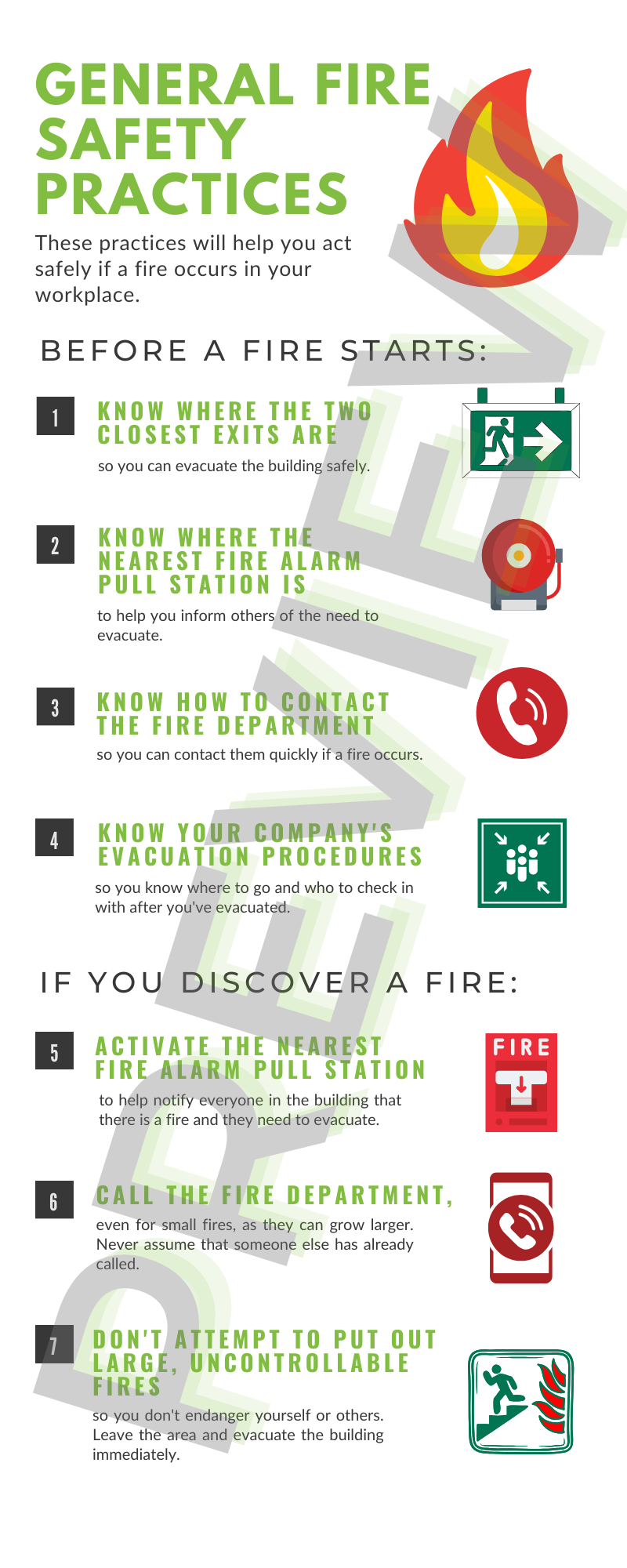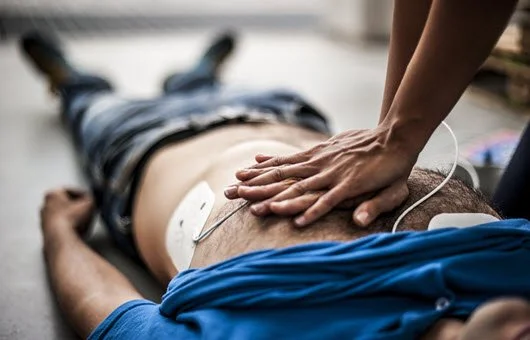Fire Safety Fundamentals 🌎
Languages: English, French, Spanish (North America)
Media Editing: The video module(s) in this subject are editable under our Content Studio offering unless otherwise indicated. For more information about Content Studio, contact your CSM.
Description: While uncommon, fires can occur in the workplace, so it's important that employees know what to do to make sure no one is injured, and that the amount of damage caused is minimal. This subject is great for helping new employees, as it focuses on the key elements of fire safety practices. Learners are taught a variety of general safety practices to make sure they are prepared and know what to do if a fire occurs in their workplace, as well as how to properly use a fire extinguisher, should the need arise.
Languages: English, French, Spanish (North America)
Media Editing: The video module(s) in this subject are editable under our Content Studio offering unless otherwise indicated. For more information about Content Studio, contact your CSM.
Description: While uncommon, fires can occur in the workplace, so it's important that employees know what to do to make sure no one is injured, and that the amount of damage caused is minimal. This subject is great for helping new employees, as it focuses on the key elements of fire safety practices. Learners are taught a variety of general safety practices to make sure they are prepared and know what to do if a fire occurs in their workplace, as well as how to properly use a fire extinguisher, should the need arise.
Languages: English, French, Spanish (North America)
Media Editing: The video module(s) in this subject are editable under our Content Studio offering unless otherwise indicated. For more information about Content Studio, contact your CSM.
Description: While uncommon, fires can occur in the workplace, so it's important that employees know what to do to make sure no one is injured, and that the amount of damage caused is minimal. This subject is great for helping new employees, as it focuses on the key elements of fire safety practices. Learners are taught a variety of general safety practices to make sure they are prepared and know what to do if a fire occurs in their workplace, as well as how to properly use a fire extinguisher, should the need arise.
Topics
General Fire Safety Practices
-
It’s important that your employees are prepared and have the knowledge required to deal with a workplace fire, so that they don’t panic and can react safely. In this topic, learners are taught what they need to know if a fire occurs to make sure they can escape safely, such as the location of the fire alarm pull station and the two closest exits. Learners are also taught what to do if they discover a fire in their workplace.
-
Questions (level 1, 2, 3)
Video module
PDF module (This module was created in a tool that is not supported by our Content Studio offering.)
-
Translated content is typically AI-generated, and in some instances, it's been human-reviewed. Review the list below for translation details within this topic.
English
French
Questions = AI-translated
Video = AI-translated
PDF = AI-translated
Spanish
Questions = human-translated
Video = AI-translated
PDF = AI-translated
-
Make sure you know the location of the two closest exits and the nearest fire alarm pull station, so you can exit safely if a fire occurs in your workplace.
Make sure you know the number for the fire department, so you can contact them quickly if a fire occurs in your workplace.
Make sure you are familiar with your company’s evacuation procedures, so you know where to go if a fire occurs, and so you can be accounted for by the appropriate people.
If you discover a fire, activate the nearest fire alarm pull station, so you can alert others of the need to evacuate the building.
If you discover a fire, regardless of its size, call the fire department, so they can deal with the fire as soon as possible. Never assume someone else already called.If you discover a large, uncontrollable fire that is quickly spreading, don’t try to put it out. Evacuate the building immediately, following your company’s evacuation procedures, so you don’t endanger yourself or others.
Preview of PDF module for “General Fire Safety Practices”.
How to Use a Fire Extinguisher
-
It’s important to understand how to properly use a fire extinguisher before a fire occurs, in order to make sure that it’s used safely and effectively. Though you should only use a fire extinguisher if you’re trained to do so, it’s helpful to remember the basics if the need to use one arises during an emergency. In this topic, learners are taught when it’s appropriate to use a fire extinguisher, and how to do so using the PASS model: pull, aim, squeeze, and sweep.
-
Questions (level 1, 2, 3)
Video Module
-
Translated content is typically AI-generated, and in some instances, it's been human-reviewed. Review the list below for translation details within this topic.
English
French
Questions = AI-translated
Video = AI-translated
Spanish
Questions = human-translated
Video = AI-translated
PDF = n/a
-
Only attempt to extinguish a fire if you’re trained to use a fire extinguisher and have the correct type of extinguisher to put out the fire; otherwise, you could injure yourself or make the fire worse.
Only use a fire extinguisher to put out small, contained fires that are just starting, to help you protect yourself or others from injury.
Make sure you have a clear escape route to use if the fire you are extinguishing spreads. If there isn’t one, don’t attempt to put out the fire, as you could injure yourself or others, and flee immediately.
When using a fire extinguisher, remember the acronym PASS to help you use it correctly.
Pull the pin at the top of the extinguisher. This will release a locking mechanism and allow you to discharge the extinguisher. ‘Pull’ represents the P in PASS.
Aim the nozzle at the base of the fire, not at the flames. This will help you extinguish the fire’s fuel. ‘Aim’ represents the A in PASS.
Squeeze the lever or trigger slowly to release the extinguishing agent inside the extinguisher. The discharge will stop when the lever is released. ‘Squeeze’ represents the first S in PASS.
Sweep the nozzle from side to side, and stand at an appropriate distance from the fire, as specified in the instructions on the extinguisher, until the fire is completely out. ‘Sweep’ represents the second S in PASS.
How to Safely Extinguish Specific Types of Fires
-
Did you know that there are specific ways to put out a fire based on what’s causing the fire? In this topic, you’ll learn how to safely extinguish grease and cooking fires, electrical fires, as well as small and containable fires of any nature. Always make sure to follow your workplace procedures in the event of a fire at work.
-
Questions (level 1, 2, 3)
Video module
PDF module (This module was created in a tool that is not supported by our Content Studio offering.)
-
Translated content is typically AI-generated, and in some instances, it's been human-reviewed. Review the list below for translation details within this topic.
English
French
Questions = AI-translated
Video = AI-translated
PDF = AI-translated
Spanish
Questions = human-translated
Video = AI-translated
PDF = AI-translated
-
If a fire of any kind is growing rapidly, evacuate the area and call emergency services as fires can grow out of control very quickly.
You can use an ABC-rated fire extinguisher on electrical fires, oil, gas, and cooking fires, as well as “ordinary combustible” fires (paper, cloth, trash, wood, etc.). They are a multi-use extinguisher that can safely put out these types of fires.
If available, use a Class K fire extinguisher on cooking fires. They’re specifically for fires involving cooking oils and grease, like animal fat or vegetable oils.
If there is any type of small fire in an oven, turn off the oven and do not open the door. The lack of oxygen will help put the fire out naturally.
If a small grease or cooking fire starts on a stovetop, cut off the oxygen to the fire by covering it with a metal pot lid or baking sheet to smother the flames. Turn off the burner and wait for the fire to go out.
For a small and manageable cooking or electrical fire, smother the fire with baking soda or salt. You will need a lot to successfully extinguish the fire.
Never try to extinguish an electrical fire with water. You could get shocked, and water may cause the fire to spread.
Electrical fires can be extinguished using a Class C or a multi-use ABC-rated fire extinguisher.
In the event of a small electrical fire, unplug the device that’s causing the fire. If you can’t unplug it safely, find another way to disconnect it from the power source, like turning off the switch, or shutting off the power at the electrical panel.
Preview of PDF module for “How to Safely Extinguish Specific Types of Fires”.








